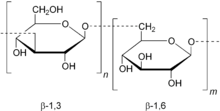Chrysolaminarin
Chrysolaminarin is a linear polymer of β(1→3) and β(1→6) linked glucose units in a ratio of 11:1.[1][2] It used to be known as leucosin.
 | |
| Names | |
|---|---|
| Other names
Chrysolaminaran; Leucosin | |
| Identifiers | |
| ChemSpider |
|
| Properties | |
| variable | |
| Molar mass | variable |
| Melting point | 273 °C (523 °F; 546 K)[1] |
| Soluble | |
Except where otherwise noted, data are given for materials in their standard state (at 25 °C [77 °F], 100 kPa). | |
| Infobox references | |
Function
Chrysolaminarin is a storage polysaccharide typically found in photosynthetic heterokonts. It is used as a carbohydrate food reserve by phytoplankton such as Bacillariophyta (similar to the use of laminarin by brown algae).[3]
Chrysolaminarin is stored inside the cells of these organisms dissolved in water and encapsuled in vacuoles whose refractive index increases with chrysolaminarin content. In addition, heterokont algae use oil as a storage compound. Besides energy reserve, oil helps the algae to control their buoyancy.[4]
gollark: They're just not very good compared to x86.
gollark: We have RISC-V CPUs now.
gollark: Personally I use LXDE.
gollark: Apparently `/etc/motd` on here is just *empty*.
gollark: gang.
References
- Beattie; Hirst, EL; Percival, E; et al. (1961). "Studies on the metabolism of the Chrysophyceae. Comparative structural investigations on leucosin (chrysolaminarin) separated from diatoms and laminarin from the brown algae". Biochem. J. 79 (3): 531–537. PMC 1205682. PMID 13688276.
- Basic definition of chrysolaminarin, Susquehanna University
- Biological use of chrysolaminarin Archived 1998-05-02 at Archive.today, California State University, Stanislaus
- Putz; Gross (2004). "Valuable products from biotechnology of microalgae". Applied Microbiology and Biotechnology. 65 (6): 635–48. doi:10.1007/s00253-004-1647-x. PMID 15300417.
This article is issued from Wikipedia. The text is licensed under Creative Commons - Attribution - Sharealike. Additional terms may apply for the media files.